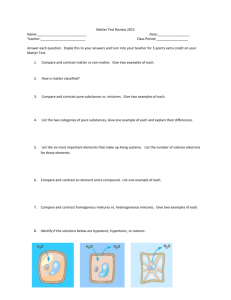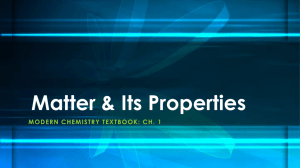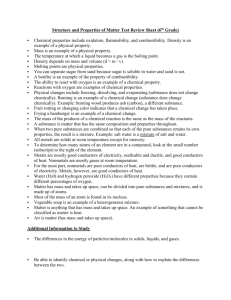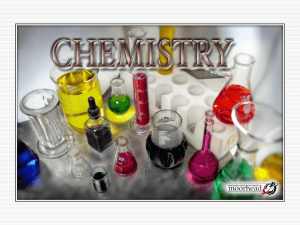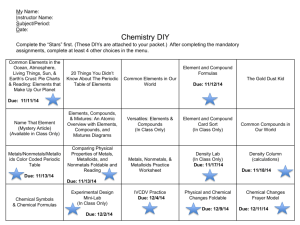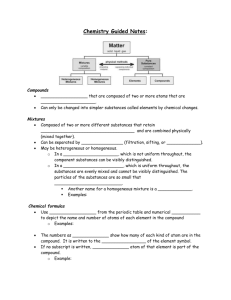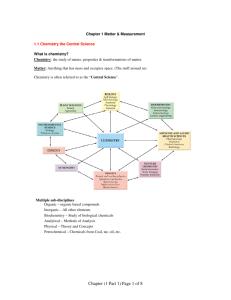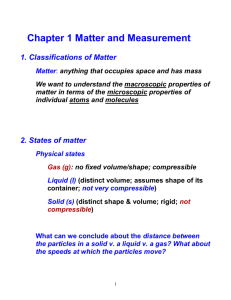Liquid State
advertisement
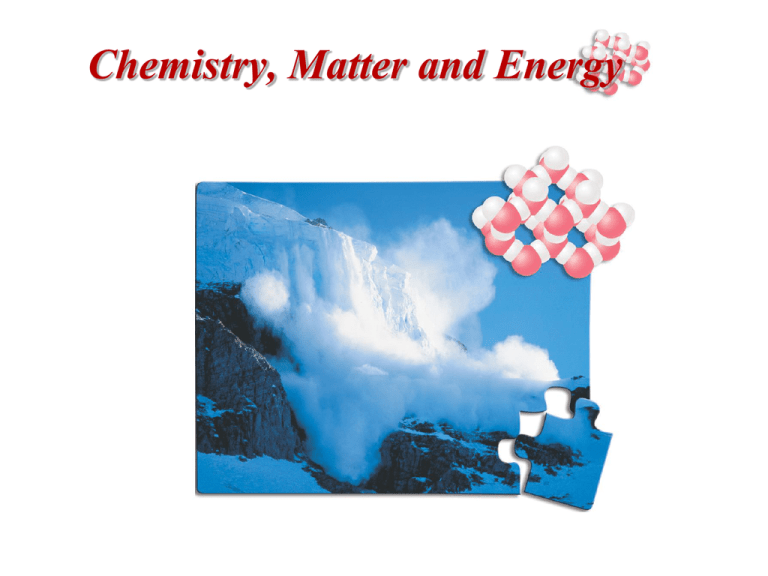
Chemistry, Matter and Energy Matter • Matter is any substance that has mass and occupies volume. • Matter exists in one of three physical state: Solid State Liquid State Gaseous State Gaseous State • In a gas, the particles of matter are far apart and uniformly distributed throughout the container. • Gases have an indefinite shape and assume the shape of their container. • Gases can be compressed and have an indefinite volume. • Gases have the most energy of the three states of matter. Liquid State • In a liquid, the particles of matter are loosely packed and are free to move past one another. • Liquids have an indefinite shape and assume the shape of their container. • Liquids cannot be compressed and have a definite volume. • Liquids have less energy than gases but more energy than solids. Solid State • In a solid, the particles of matter are tightly packed together. • Solids have a definite, fixed shape. • Solids cannot be compressed and have a definite volume. • Solids have the least energy of the three states of matter. States of Matter Summary • Gases have the most energy of the three states of matter. • Liquids have less energy than gases but more energy than solids. • Solids have the least energy of the three states of matter. Changes of State • Most substances can exist as either a solid, liquid, or gas. • Water exists as a solid below 0°C; as a liquid between 0°C and 100°C; and as a gas above 100°C. • A substance can change physical states as the temperature changes. Solid/Liquid Phase Changes • When a solid changes to a liquid, the phase change is called melting. • A substance melts as the temperature increases. • When a liquid changes to a solid, the phase change is called freezing. • A substance freezes as the temperature decreases. Liquid/Gas Phase Changes • When a liquid changes to a gas, the phase change is called vaporization. • A substance vaporizes as the temperature increases. • When a gas changes to a liquid, the phase change is called condensation. • A substance condenses as the temperature decreases. Solid/Gas Phase Changes • When a solid changes directly to a gas, the phase change is called sublimation. • A substance sublimes as the temperature increases. • When a gas changes directly to a solid, the phase change is called deposition. • A substance undergoes deposition as the temperature decreases. Changes of State Classifications of Matter • Matter can be divided into two classes: – Mixtures – Pure Substances • Mixtures are composed of more than one substance and can be physically separated into its component substances. • Pure substances are composed of only one substance and cannot be physically separated. Mixtures • There are two types of mixtures: – Homogeneous Mixtures – Heterogeneous Mixtures • Homogeneous mixtures have uniform properties throughout – Saltwater is a homogeneous mixture • Heterogeneous mixtures do not have uniform properties throughout – Sand and water is a heterogeneous mixture Pure Substances • There are two types of pure substances: – Compounds – Elements • Compounds can be chemically separated into individual elements. – Water is a compound that can be separated into hydrogen and oxygen. • An element cannot be broken down further by chemical reactions. Occurrence of the Elements • There are over 100 elements that occur in nature. 81 of those elements are stable. • Only 10 elements account for 95% of the mass of the Earth’s crust: Elements in the Human Body • Oxygen is the most common element in both the Earth’s crust and in the Human body. • While silicon is the second-most abundant element in the crust, carbon is the second most abundant in the body. Names of the Elements • Each element has a unique name. • Names have several origins: – Hydrogen is derived from Greek – Carbon is derived from Latin – Scandium is named for Scandinavia – Nobelium is named for Alfred Nobel. Element Symbols • Each element is abbreviated using a chemical symbol. • The symbols are 1 or 2 letters long. • Most of the time, the symbol is derived from the name of the element. – C is the symbol for carbon – Cd is the symbol for cadmium • When a symbol has a two letter symbol, the first is capitalized and the second is lower case. Other Element Symbols • For some elements, the chemical symbol is derived from the original Latin name. Gold – Au Sodium – Na Silver – Ag Antimony – Sb Copper – Cu Tin – Sn Mercury – Hg Iron – Fe Potassium – K Tungsten – W Types of Elements • Elements can be divided into three classes: – Metals – Nonmetals – Semimetals or metalloids • Semimetals have properties midway between those of metals and nonmetals Properties of Metals • Metals are typically solids with high melting points and high densities and have a bright, metallic luster. • Metals are good conductors of heat and electricity. • Metals can be hammered into thin sheets and are said to be malleable. • Metals can be drawn into fine wires and are said to be ductile. Properties of Nonmetals • Nonmetals typically have low melting points and low densities and have a dull appearance. • Nonmetals are poor conductors of heat and electricity. • Nonmetals are not malleable or ductile and crush into a powder when hammered. • 11 nonmetals occur naturally in the gaseous state. Periodic Table of the Elements • Each element is assigned a number to identify it. It is called the atomic number. • Hydrogen is 1, Helium is 2, up to Uranium which is 92. • The elements are arranged by atomic number on the periodic table. The Periodic Table Metals, Nonmetals, and Semimetals • Metals are on the left side of the periodic table, nonmetals are on the right side, and the semimetals are in between. Physical States of the Elements Physical & Chemical Properties • A physical property is a characteristic of a pure substance that we can observe without changing its composition. • Physical properties include appearance, melting and boiling point, density, conductivity, and physical state • A chemical property describes the chemical reactions of a pure substance. Chemical & Physical Changes • A physical change is a change where the chemical composition of the substance is not changed. • These include changes in physical state or shape of a pure substance. • A chemical change is a chemical reaction. • The composition of the substances changes during a chemical change. Evidence of a Chemical Change • Gas release (bubbles). • Light or release of heat energy. • Formation of a precipitate. • A permanent color change. Conservation of Mass • Antoine Lavoisier found that the mass of substances before a chemical change was always equal to the mass of substances after a chemical change. • This is the law of conservation of mass. • Matter is not created or destroyed in physical or chemical processes. Potential and Kinetic Energy • Potential energy, PE, is stored energy; it results from position or composition. • Kinetic energy, KE, is the energy matter has as a result of motion. • Energy can be converted between the two types. • A boulder at the top of the hill has potential energy; if you push it down the hill, the potential energy is converted to kinetic energy. KE, Temperature, & State • All substances have kinetic energy no matter what physical state they are in. • Solids have the lowest kinetic energy, and gases have the greatest kinetic energy. • As you increase the temperature of a substance, its kinetic energy increases. Conservation of Energy • Just like matter, energy cannot be created or destroyed but it can converted from one form to another. • This is the law of conservation of energy. • There are six forms of energy: heat, light, electrical, mechanical, chemical, and nuclear. Energy and Chemical Change • In a chemical change, energy is transformed from one form to another. For example: Law of Conservation of Mass and Energy • Mass and energy are related by Einstein’s theory of relativity, E = mc2. • Mass and energy can be interchanged. • The law of conservation of mass and energy states that the total mass and energy of the universe is constant. Separation of Mixtures Distillation Separates homogeneous mixture on the basis of differences in boiling point. Filtration Separates solid substances from liquids and solutions. Chromatography Separates substances on the basis of differences in solubility in a solvent. Conclusions • Matter exists in three physical states: – Solid – Liquid – Gas • Substances can be converted between the three states. • Substances can be mixtures or pure substances. Conclusions Continued • Pure substances can be either compounds or elements. • The elements are arranged in the periodic table. • Each element has a name and a 1 or 2 letter symbol. • Elements are classified as either metals, nonmetals, or semimetals. Conclusions Continued • A physical change is a change in physical state or shape. • A chemical change is a change in the chemical composition of a substance. • Both mass and energy are conserved in chemical and physical changes.
